What’s Up with Sitting Down?
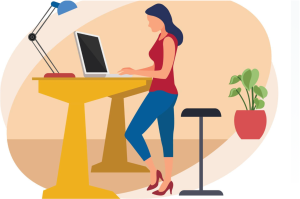 Until fairly recently, much of the Research focus for healthy living was on increasing physical activity levels and meeting physical activity national guidelines (CDC 2024). Sitting was more of an “under the radar” health and wellness factor. Not really thought about that much – just lurking in plain sight and not often remarked on.
Until fairly recently, much of the Research focus for healthy living was on increasing physical activity levels and meeting physical activity national guidelines (CDC 2024). Sitting was more of an “under the radar” health and wellness factor. Not really thought about that much – just lurking in plain sight and not often remarked on.
More recent Research though, finds that sitting has become a major component of life. Over 80% of all US jobs are predominantly sedentary, and according to the U.S. Bureau of Labor Statistics, the average civilian worker can spend almost 50% of the workday sitting at their desk. Some studies report that conventional desk-based office work may involve as much as 7 hours a day of continuous sitting (Ma et al., 2021). The traditional college/school day can be the same (Chrisman et al.2021). Education is mainly a seated experience! And this does not include all the additional sitting we do at home, after work while watching TV, reading, relaxing, driving etc.
The reality is that most of our “Daily Inactivity” involves sitting – and there is a LOT of sitting going on out there!
This – as it turns out – does not sit well with health. Anyone’s health. Research has linked prolonged sitting with higher risk of a range of adverse health conditions.
Sitting is the New Smoking
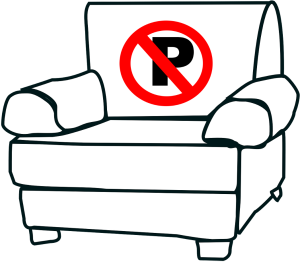 Maybe you have heard the phrase “Sitting is the new smoking”, often attributed to Dr. James Levine, a Mayo Clinic research professor. In a 2014 interview with the LA Times, he stated that “Sitting is more dangerous than smoking, kills more people than HIV and is more treacherous than parachuting. We are sitting ourselves to death.”
Maybe you have heard the phrase “Sitting is the new smoking”, often attributed to Dr. James Levine, a Mayo Clinic research professor. In a 2014 interview with the LA Times, he stated that “Sitting is more dangerous than smoking, kills more people than HIV and is more treacherous than parachuting. We are sitting ourselves to death.”
Dr. Levine is also attributed with the related phrase “The Chair is a Killer”.
So, as well as all this Research on the importance of increasing the amount of moving about, there has, more recently, also been this focus on methods of reducing the amount of sitting about—at work, school or home.
Which brings us to …
Standing Desks
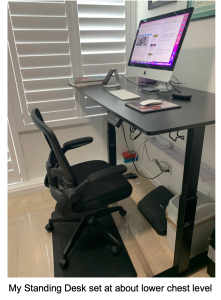 The increase in “Sit Less” Research led to the development of work desks specially designed to be used while standing. Initially, “Standing Desks” involved a simple wooden platform placed on top of a regular desk – providing a raised, fixed height surface suitable for working while standing.
The increase in “Sit Less” Research led to the development of work desks specially designed to be used while standing. Initially, “Standing Desks” involved a simple wooden platform placed on top of a regular desk – providing a raised, fixed height surface suitable for working while standing.
More recent models (like the one I am using to write this post) are “Sit-to-Stand” desks—electronically controlled and able to vary the desk height smoothly and silently to suit working in either a sitting or standing position
Standing Desk Benefits – Research Findings
Over the last decade or more, Research has consistently reported improved health benefits when people sit less and stand more. This included reduced daily sitting time (McLachlan et al., 2022), increased daily energy expenditure (Roemmich et al., 2016), reduced neck, back, and shoulder pain, improved subjective health, overall work performance, work vitality and work efficiency (Ma et al., 2020, Nelson-Wong et al., 2022).
Similar findings have been reported for the use of standing desks in medical and school/college setting (Chrisman et al., 2021, McLachlan et al., 2022)
All that good stuff just from standing up a little more.
Here’s an example
Ma et al., 2020 Ma, J. et al. Effects of a Workplace Sit–Stand Desk Intervention on Health and Productivity. Int. J. Environ. Res. Public Health 2021, 18, 11604.
Authors investigated the benefits of using a sit to stand desk compared to a traditional seated desk. Each participant in the intervention group received a personal sit–stand desk that allowed them to switch between sitting and standing positions and set their desk height freely during work hours.
Here’s what they found after 4 weeks
- Compared to the regular group, the Sit to Stand group significantly decreased their sitting time at work, and experienced reduced neck and shoulder pain.
- They also improved in a number of other wellness related measures including subjective health, vitality and work performance.
In other words, using a sit to stand desk reduced sedentary behavior and improved participants health and productivity.
Brief History of Standing Desks
 I converted to a Standing Desks about a year ago, and, TBH, had initially thought of this as a relatively new approach – almost a novelty. How wrong was I! My Research found that standing desks have been around for a long, long time. For example, Leonardo da Vinci is reported to have used one way back in the late 1400s. Standing desks were also common work stations for clerical workers in the late 1800s.
I converted to a Standing Desks about a year ago, and, TBH, had initially thought of this as a relatively new approach – almost a novelty. How wrong was I! My Research found that standing desks have been around for a long, long time. For example, Leonardo da Vinci is reported to have used one way back in the late 1400s. Standing desks were also common work stations for clerical workers in the late 1800s.
Other historical standing desk “Notables” were Thomas Jefferson, Charles Dickens, Ernest Hemingway and Winston Churchill.
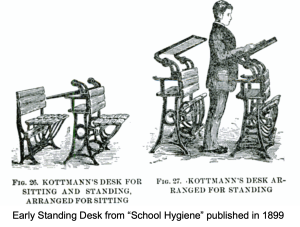

Today Standing Desks are used extensively in tech companies such as Google and Facebook.
For more information, check out this really interesting post on Standing Desk history.
Standing Desk Guidelines
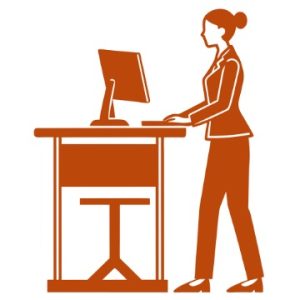 So, while Research findings support the health benefits of Standing vs Sitting at a desk, there are some basic guidelines that will help to smooth this change of “Desk Behavior”
So, while Research findings support the health benefits of Standing vs Sitting at a desk, there are some basic guidelines that will help to smooth this change of “Desk Behavior”
Briefly, the idea is not to completely switch from always sitting to always standing. The ideal approach is to gradually—and intermittently—add standing time at your work desk and vary the frequencies and durations. This is much more convenient with a motorized desk. And, as they say, “It worked for me”.
NOTE: The British Medical Journal and the British Journal of Sports Medicine issued a press release with guidelines based on expert analysis of published Research on Standing and Sitting. You can read these guidelines here.
Here’s my own list of basic Guidelines to help the switch be more switchable
1. Make the change gradually.
This is really the main guideline to follow
Allow time to adapt. There are no set numbers here – no standing goals to achieve. It will all vary according to the individual.
Start with a few minutes of standing alternated between your regular sitting. Gradually increase the time and/or frequency of standing. Monitor your body’s response and work within your comfort level.
From my own personal experience, when I first started Desk Standing I experienced some discomfort in my feet and knees. But when I cut back a little and used shorter standing sessions things went back to being ok, and I eventually built up to longer (and more comfortable) standing periods.
2. Ensure your Standing Desk is at the right height
Adjust desk height so that, when your palms are placed on the desktop, elbows are at a 90-degree angle or greater Your mid-screen height should be at, or slightly below, eye level.
3. Try an anti-fatigue mat
Your feet may start to feel tired or stressed as you adapt to the new standing behaviour. I can attest to that myself! Some of this can be eased by using an anti-fatigue standing desk mat (Yes that is what they are called!). These are specially cushioned mats that will increase your standing comfort and may also encourage small amounts of movement when standing. NOTE: I can attest to that one also. I am standing on one right now!
4. Move a Little
Be a little fidgety. Shift body positions while standing, move away from desk occasionally.
Final Comments
There are Research-supported health benefits to reducing daily sitting times, and conventional office work provides the greatest opportunity to switch from always sitting to sometimes standing. These benefits are more likely to safely accrue if the above guidelines are followed (Sit for a bit, stand for a bit, sit for a bit more – repeat)
It is important to note that, although standing is better than sitting, it does not replace exercise/physical activity. Continue to look for ways to be a little more active throughout the day. CHECK OUT MY RECENT BOOK “Park Further Away” for options and ideas.
NOTE: If you are interested in obtaining more information on Standing Desks or if you feel that Research could Matter to some aspect of your business or lifestyle…
Contact Dr. Phillips directly at wphillips@syfound.com – or use our Contact Page
